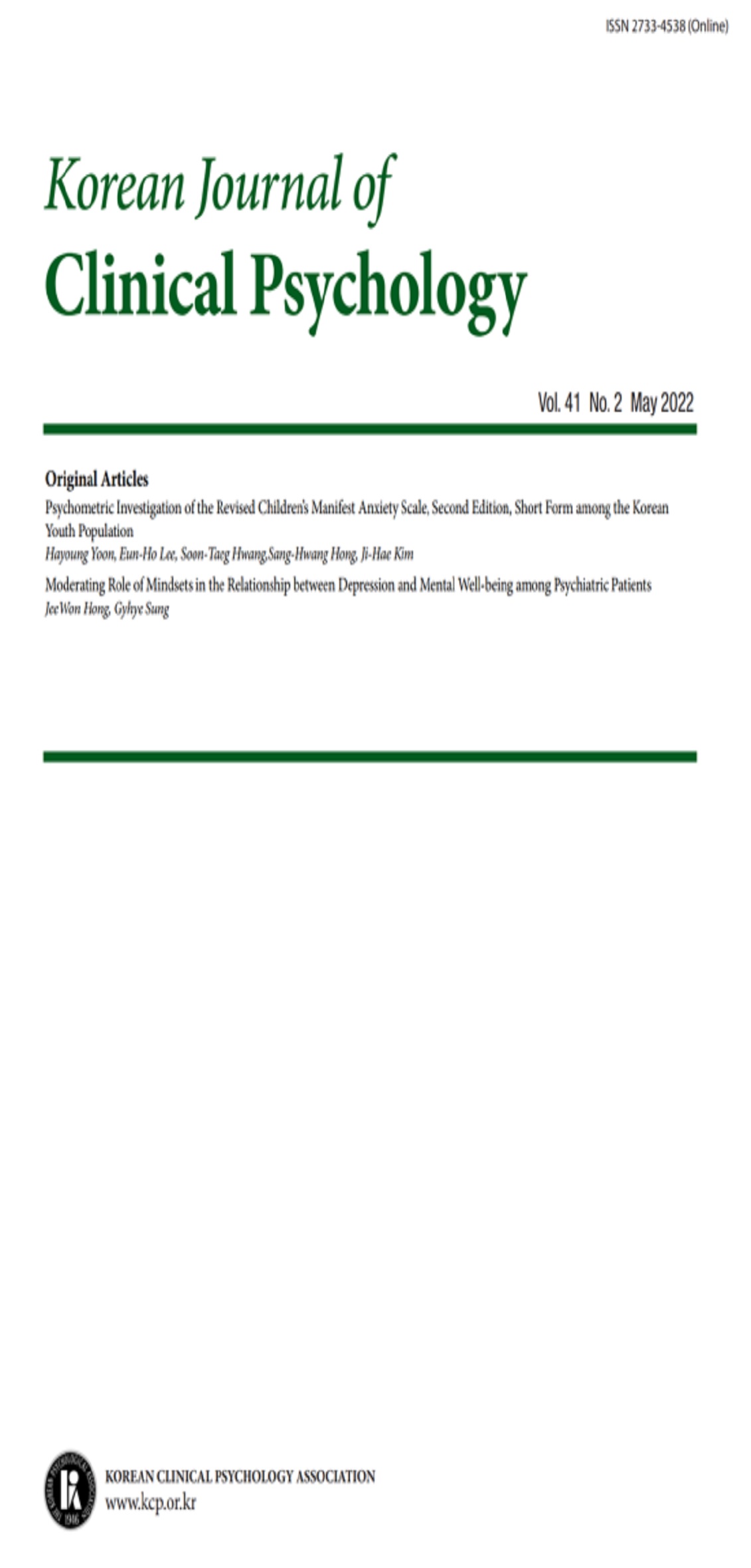open access
메뉴
open access
메뉴 E-ISSN : 2733-4538
E-ISSN : 2733-4538
Some earlier studies indicated that social concerns dimension of anxiety sensitivity(AS) would be involved in social anxiety or social phobia. The present study evaluated the utility and specificity of AS-social concerns in predicting anxious response to a public speaking task. Anxious responding that 155 university students experienced before and during an impromptu public speaking was measured with several self-report assessment tools. The results of hierarchical multiple regression analysis revealed that AS-social concerns dimension significantly predicted modified versions of the Beck Anxiety Inventory prior to and following a public speaking, cost estimate for anxiety appearance, anxiety expectation, performance expectation, and ending anxiety during a public speaking after controlling for the effects of the other dimensions of AS, whereas the other dimensions of AS mostly did not. The effect of AS-social concerns dimension on anxious responses to a public speaking task was mediated through cost estimate for anxiety appearance. The findings suggest that the importance of AS-social concerns dimension should be considered in order to understand clients with social anxiety/phobia(particularly public speaking anxiety) more systematically and treat them more effectively.
(2001) 발표불안에 대한 인지행동집단치료의 효과,
(2003) 불안민감성 차원: 한국판 개정된 검사의 요인 구조,
(2006) 역기능적 신념과 발표상황의 불안반응간의 관계에서 부정적인 자동적 사고의 매개효과,
(2004) 한국판 불안통제질문지의 심리측정적 속성,
(2003) 한국판 Beck Anxiety Inventory의 요인구조 정신과 환자를 대상으로 한 확인적 요인분석의 적용,
(1986) The moderator-mediator variable distinction in social psychological research Journal of Personality and Social Psychology,
(1988) An inventory for measuring clinical anxiety Journal of Consulting and Clinical Psychology,
(2002) Acceptance or change of private experiences:A comparative analysis in college students with public speaking anxiety, University of Albany, State University of New York.
(1995) A cognitive model of social phobia, Guilford Press
(2001) Clinical handbook of psychological disorders, Guilford Press
(2003) Psychometric properties and factor structure in two nonclinical samples,
(2001) Social phobia: An information processing perspective., Allyn & Bacon
(1996) Cognitive biases in generalized social phobia ,
(1986) Emotional processing of fear:Exposure to corrective information,
(1991) Cognitive behavioral treatment of social phobia in a group setting Unpublished manuscript available from the Center for Stress and Anxiety Disorders,
(2001) Assessment of social anxiety and social phobia , Allyn and Bacon
(2004) Cognitive mediation of treatment change in social phobia,
(2000) An instrument assess self-statements during public speaking:Scale development and preliminary psychometric properties,
(1983) A brief version of the fear of negative evaluation scale,
(1993) Anxiety sensitivity:An examination of theretical and methodological issues,
Behavioral assessment: Self-report, physiology, and overt behavior. , Guilford Press
(2000) Does the social concerns component of the anxiety sensitivity belong to the domain of anxiety sensitivity or the domain of negative evaluation sensitivity,
(1997) Personality factors associated with generalized and non- generalized social anxiety,
(1994) Social phobia and response to challenge procedures:Examining the interaction between anxiety sensitivity and trait anxiety,
(2001) The effects of interoceptive exposure on fear reduction and return of fear in individuals with public speaking anxiety, University of California, Los Angeles.
(1997) Perceived threat and perceived control as predictors of the degree of fear in physical and social situations,
(1987) Theoretical perspectives on the fear of anxiety,
(1991) Expectancy model of fear,
(1985) The expectancy model of fear Theoretical issues in behavior therapy, Academic Press
(1986) and the prediction of fearfulness,
(1995) Anxiety sensitivity:Theoretical perspectives and recent findings,
(1998) An expanded anxiety sensitivity index: Evidence for a Hierarchic structure in a clinical sample. ,
(2001) Social anxiety disorder, Guilford Press
(2004) Probability and cost estimates for social and physical outcomes in social phobia and panic disorder ,
(1996) Structure of anxiety and the anxiety disorders:A hierarchical model,
(1997) Hierarchical structure and general factor saturation of the Anxiety Sensitivity Index:Evidence and implications,
(1999) Dimensions of anxiety sensitivity, Erlbaum
